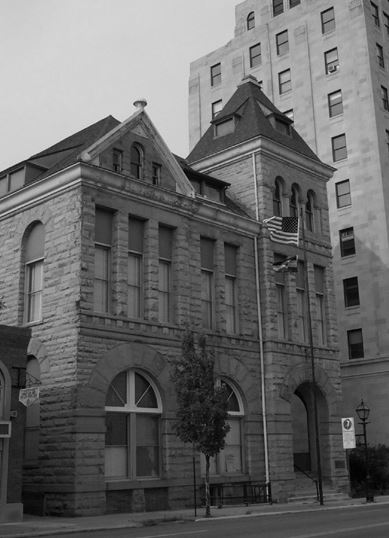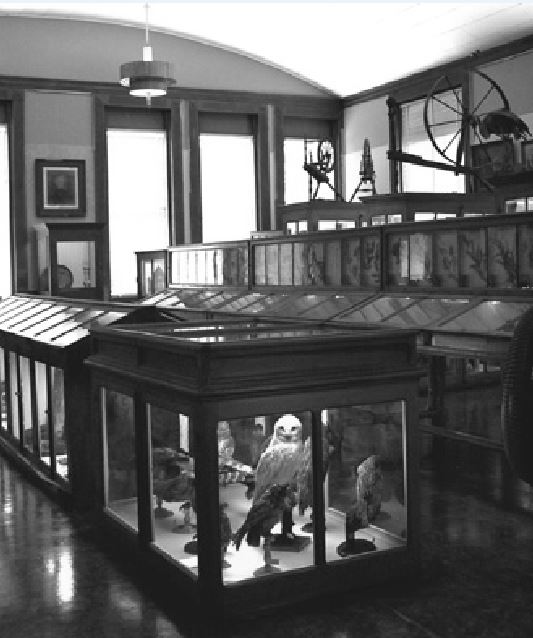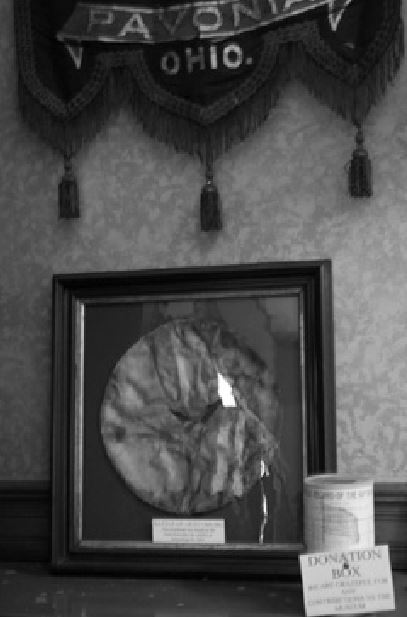The Mansfield Memorial Museum: Celebrating Atlas Obscura Day in Ohio

The Mansfield Memorial Museum
It’s Atlas Obscura Day again! And once again Ohio has failed to deliver sacrificial standing stones, taxidermied kitten tea parties, or big balls of string. One can only suppose that the hurly burly of the impending GOP Convention in Cleveland has distracted the state from its duty to the Tourists of the Obscure. There are only two official events planned for Ohio: “Inside the Troll Hole,” a visit to a troll doll museum in Alliance, hosted by Sigrid, Queen of Trolls; and Planet-Gazing at the Cincinnati Observatory, the “Birthplace of American Astronomy.” Fair enough if you like troll dolls or telescopes. At least this year there is a quirky event instead of mere science. Last year I had to offer a severe corrective to rationality in the form of a Hatchet Man’s gravesite.
Since I wasn’t invited to be on any Atlas Obscura events committees, in a strictly unofficial capacity, I would like to recommend a truly obscure wonder of Ohio in The Mansfield Memorial Museum, a true 19th-century wunderkammer and home to a taxidermied tea-party for poultry as well as at least one ghost.
This massive stone building started life as the Soldiers and Sailors Memorial Building and is the oldest continuously used veteran’s building in Ohio. (The GAR building in Sydney, built in 1876, is the oldest chronologically.)
The original Mansfield Memorial Museum whose mission was “preservation and education” was housed on the third floor. It was the brain-child of Mr. Edward Wilkinson, a tinner by trade. Wilkinson was one of those self-taught working-man naturalists the Victorian era produced in such quantities. He was trained as a geologist and in the late 1860s to mid-1870s he traveled as an “acquisioner”—a collector of specimens for the Smithsonian Institution. He visited Mexico to work in his aunt’s silver mine and collected specimens for the Field Museum in Chicago, the Peabody, and the Carnegie. Wilkinson was recognized as the pre-eminent naturalist of the Midwest. He often asked other fellow enthusiasts like Dr. J.W. Craig to bring specimens home from their travels, perhaps casually asking, “While you’re in Australia, would you mind picking me up an emu?”
From 1889 to 1897, some 65,000 people came through the Museum—this at a time when the entire population of Mansfield was only 14,000. Hailed as the premier museum in the Midwest, it was the place to visit. The building was never locked and the curator has had older people tell him about visiting the Museum as children, then running over to the Madison Theatre for a matinee.
Wilkinson died in 1918 of arsenic poisoning. It was rumored that he was poisoned by the arsenic solutions used to preserve the Museum’s stuffed animals but he actually died from inhaling the arsenic given off in tin processing.
After his death, a local scoutmaster organized the local children who cleaned glass, dusted, and swept from the 1920s until 1955 when, Victorian museums having fallen out of fashion, the Museum was closed. It was closed for forty-four years—until Scott Schaut came to town.
“I found the Museum by accident. I have a background in museum work and had come from Washington where real estate is so expensive. I was looking for something I could afford and bought a house in Sherman’s Estate. As I was doing some research, I found a picture labeled “Edward Wilkinson, Director and Curator, Mansfield Memorial Museum” in the 1896 Richland County Atlas.
“I asked around about the Museum and was told that it had been closed for years. Some local people told me not to bother to try to see the museum because it had been stripped of all valuable items and only contained some insects and stuffed birds.”
Scott persisted, going back repeatedly until he found one of the Board members, Mr. Gib Fronz, in the building.
“He look me upstairs through all of the cobwebs and I couldn’t believe what I was seeing. I was in Heaven! It was as if the museum was frozen in time from before the museum had closed. Every week for eight months I was allowed to go to the museum and just look at all of the artifacts and history that had been shut away.”
Scott inherited a treasure-trove of chaos. Another fire had swept through the Museum in 1986 when the old Madison Theatre was being torn down. Most of the collection was coated in soot. A Civil War-era print hangs in the Museum. Half of it has been cleaned; the other half is covered with a black film of soot. It is a graphic illustration of the massive cleanup Scott has accomplished.
In November 1997 Scott was appointed Director and Curator for Life by the Board in recognition for his commitment to the Museum. The Museum reopened on Memorial Day 1999.
When I visited, I expected to find a grubby local military museum full of dusty displays of rusted minie ball fragments with fly-specked signs: “Dug up on Gettysburg Battlefield.” Instead I found a cabinet of curiosities, a Victorian museum that time forgot.

At the door, I was stunned to find myself back in the nineteenth century. Spiky egrets and spinning wheels were silhouetted on top of wooden display cases in the late-afternoon light. A snowy, skull-faced barn owl glared at me from a case by the door.
It was the variety of exhibits that was so enchanting. From a framed “Drumhead found on the Battlefield of Gettysburg, 1863” to a memorial wreath for President Garfield to the wonderfully out-of-period deco lamps, it could have been just another badly arranged local historical society museum. Instead it was a treasure hunt.

Drumhead found on the Gettysburg Battlefield
I started beside a bare tree trunk labeled, “planted by Johnny Appleseed.” Here was a handmade wooden cash register. There was the lower jaw of a tiger owned by P.T. Barnum, and a circus drum. Pressing onward, there was a row of cases containing military uniforms, Ice Age-era wood, a mastodon’s jaw bone, Philippine be-heading swords, the frock coat of Senator John Sherman, who ran for president in 1888. A velocipede or “bone shaker” bicycle made by the Museum’s director Mr. Wilkinson in 1868 shared a case with a moth-eaten parrot, “27 years old at the time of death” and sheets of 1846 wallpaper.
Every artifact competed for my attention: stockings from the Revolutionary War, a plait of hair labeled in Wilkinson’s hand: “relic of Johnstown flood,” botanical specimens pressed flat behind glass, the original chain and compass used to survey Richland County.
The collection included stuffed animals and birds of every description including costumed ducks and a rooster sitting around a Victorian tea table. One case was full of guns taken by John Brown from the Harper’s Ferry Armory as well as the most unique piece in the Museum: a pike, or spear-like weapon, one of 1,000 made by Brown to arm the slaves he intended to free in the uprising.
“Only three of these are known to exist,” Scott told me later. ”Even the Smithsonian doesn’t have one.”
There seems to be nothing that Wilkinson did not collect. It is an amazing, eclectic collection, all housed in period wooden cases that are as marvelous as their contents. When the Smithsonian held a grand exposition in 1876 in honor of the country’s centennial, they designed a series of elegant wood and glass display cases. When Mr. Wilkinson wrote for information on setting up his Museum, the Smithsonian sent him the plans for the centennial cases.
Exhausted by the sheer volume of it all, I walked out of the main Museum room, past a case of Zulu spears and stuffed monkeys, past a rainbow of birds arranged in a smaller case.
Scott unlocked the grill and climbed the stairs to the third floor ahead of me. It was like King Tut’s tomb or the warehouse at the end of Raiders of the Lost Ark: I could see the original stenciled wall decoration, the paint lighter where it had been hidden and preserved by a huge case. An enormous curved wooden truss, six layers of wood thick, holds up the entire building. A stuffed peacock sprawled atop a tall case. “The moths got at the tail feathers,” Scott remarked. “There’s a local man who raises peacocks. I’m going to ask him for feathers to replace them.”
The entire Museum was originally housed on this floor. But the Fire Marshall told Scott that he would have to move the displays down to the second floor since there was only one way in and out of the third floor. All the cases with their original glass had to be taken apart since they were too large to be moved in one piece.
“We only broke one pane moving the cases, and that was my fault,” Scott confessed. “The rest of the glass is completely original.”
The move seemed to agitate the ghost, which Scott feels may be Edward Wilkinson, whose life was devoted to the Museum.
“When I first got here, I felt like the mood was, ‘what are you doing?’ We had to dismantle the cases, move them, reassemble them. You’re looking at three and a half years work. But as soon as I finished reassembling the cases, the mood changed from worry to contentment.”
Back downstairs in the second-floor Museum room, Scott pointed at a framed photo of a bearded man who looks very pleased.
“That’s Edward Wilkinson’s picture. It hung on the third floor. When we started moving things down and this room was empty, I took the picture and hung it first thing in this room. I swear to God, he wasn’t smiling when we first brought it down…
“There have been two sightings of a man. The first was when we had just put the cases in. There were no artifacts in them yet. I was standing at the third uniform case. It was about this time of day [5:00 p.m.] and I could see the west windows reflected in the case windows. I saw the shadow of a man, passing from left to right. There were no details, just an adult-sized man’s shadow. It lasted about fifteen seconds.
“The other time, a volunteer was downstairs in the library reading room and saw a shadow go past the doorway.
“But I’ve also heard him sneeze. It was the middle of winter. There was some noise, the building creaking, etc., but all the windows were shut. I was sitting by the front desk when I heard a sneeze from upstairs. Sound travels very well down the stairwell. Of course, I went right upstairs. ‘Hello?’ I said, ‘Is anybody there?’ Of course, nobody was there.
“About four hours later on the same day I went into the reading room of the library and I heard it again from upstairs. Both of sneezes were a man’s sneeze, rather muffled.
“I’m not the only one who hears things. I was working in the basement while a pair of volunteers, a man and a woman, were sitting at the desk in the front hall. They heard steps, first on the second floor, then going up to the third floor. Then I came up from the basement.” The couple was completely shocked.
“How did you get past us?” they asked Scott.
“I told them that I hadn’t been upstairs at all, that I’d been in the basement the whole time. I said that it was just Mr. Wilkinson checking the museum and the building like he always does.”
In the years while the Museum was closed, board members would sometimes be there alone, dusting. They’d hear footsteps or noises realistic enough to make them think that another board member had come into the building. They would walk down to the first floor, but never find anyone there. There was always the feeling of somebody being around.
As I was shouldering my camera to leave, I suddenly realized that I hadn’t taken a photo of Mr. Wilkinson. Scott stayed behind as I dashed up the stairs. As I turned left in the hall, I caught a glimpse of someone behind me and jumped about a foot. Then I realized that there was no one there and scolded myself for letting my imagination run away with me.
Back downstairs, I told Scott that I was getting imaginative. He smiled. “Oh, that happens all the time: people thinking that someone is right behind them.”
As for ghosts, the little boy I saw is a mystery. Perhaps he is the Spirit of the Museum, representing the thousands of children who have walked these halls, exclaiming over the emu, awed by the guns, giggling at the stuffed ducks at tea.
When I asked Scott what his favorite artifact was he first mentioned a collection of children’s artwork from 1901. “They’re pieces of time, stopped.” Another favorite is the Johnny Appleseed tree. Scott had no idea of its significance when he first came to the Museum, since the label had been lost.
“When we first opened, a gentleman in his nineties approached me. He told me that he used to help out at the Museum.
“‘Too bad you don’t have those trees anymore,’ he said. ‘I remember having to dust those damn trees.’
“‘Really?’ I said. ‘Why is it too bad?’
“‘Because Johnny Appleseed planted them.’
“Well, we had those trees. We just didn’t know what they were. The trees had been planted between 1812 and 1815. There were two pieces—a large trunk and a smaller piece.
“‘Every time I dusted,’ said the old gentleman, ‘a piece of bark fell off!’
“So we were able to label them and put them back on display,” Scott finished with satisfaction.
Scott has many plans for the future.
“We’ve got minerals and fossils that are not on display yet. I think we’ve got the nicest collection of seashells in the state. The insects are also not on display. We’ve got thirteen species of extinct birds and a beautiful skull collection.”
One unique item that Scott has added to the collection is the robot Elecktro, a smoking, wise-cracking robot from the 1939 World’s Fair.
Eventually Scott wants to put the twenty feet back on the building, taken down when the Madison Theatre was built, add an elevator, and a repository room on the third floor, where specimens can be stored until needed for loan or display. I complimented Scott on a truly unique museum experience. “We’ve come a long way in a short period of time,” he said.
“This Museum was Mr. Wilkinson’s life—his legacy to the community. It is now my life and, in my small way, my legacy to leave for future generations. I tell people that when I die I want to be cremated and the ashes put on the third floor. And if anything is changed I’ll come out of the woodwork, like Poltergeist, and haunt the place!”
Visiting the site
The second floor is not currently handicapped accessible. The first floor, which is dedicated to military history, is accessible via a ramp. The Mansfield area is well-known for its many haunted sites including The Ohio State Reformatory, Oak Hill Cottage, Malabar Farm, and the Renaissance Theatre. (See Ghost Hunter’s Guide to Haunted Ohio and Haunted Ohio V: 200 Years of Ghosts for details.
Mansfield Memorial Museum
34 Park Ave. West
Mansfield, OH 44902
(419) 525-2491
Located next to the Bank One building (north side) one block west from the city square on Park Avenue.
This post has been adapted from the chapter on the Mansfield Memorial Museum in Ghost Hunter’s Guide to Haunted Ohio. I feel like I should apologize for a lack of quality photos–at the time I was there, my camera was malfunctioning and the three photos above are all that survive. There are, however, many photos of the site online.
Chris Woodyard is the author of The Victorian Book of the Dead, The Ghost Wore Black, The Headless Horror, The Face in the Window, and the 7-volume Haunted Ohio series. She is also the chronicler of the adventures of that amiable murderess Mrs Daffodil in A Spot of Bother: Four Macabre Tales. The books are available in paperback and for Kindle. Indexes and fact sheets for all of these books may be found by searching hauntedohiobooks.com. Join her on FB at Haunted Ohio by Chris Woodyard or The Victorian Book of the Dead.
